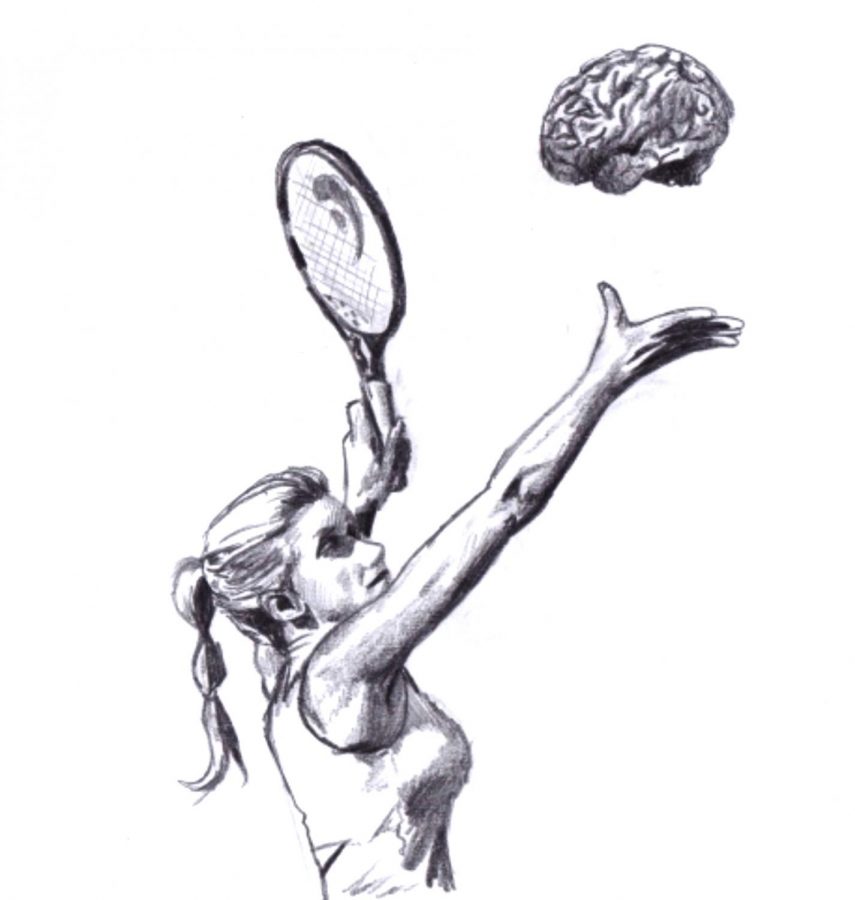Mental Health in Sports
February 6, 2020
Athletic competition can breed greatness. It fosters resilience, innovation and passion — qualities every parent wants to instill in his or her child. Competition in sports, by its nature, requires each athlete to meet and overcome challenges. But, the positive qualities that sports nurture can become destructive if taken to the extreme. Confidence is key, but overconfidence is toxic. A will to win is critical, but an inability to lose graciously is debilitating.
Since the ups and downs of sports mirror the ups and downs of life, each struggle can expose problematic behavior that needs to be addressed. And maintaining this balance between extremes is especially difficult during adolescence.
I have experience with such struggles. When I started playing tennis competitively at the age of six, I was impatient, overconfident and a sore loser. While tennis allowed me to work on balancing those extreme emotions, that effort also diminished some of the passion I had when I first started the sport. After enough losses, I taught myself to stop caring. When I felt like a match might be close, I would go in predicting and accepting defeat before it happened to protect myself from the pain of losing. The prediction of the loss would be a self-fulfilling prophecy.
I joined the Pali varsity tennis team my freshman year optimistic but wary, knowing that I would be playing singles and have a major impact on the team’s success. It was the first time I had a whole group of people relying on my support, energy and skill to win championships. Before each match, my hands shook uncontrollably and my stomach throbbed. I was always uncomfortable, always fearful of what was to come and always nervous.
The case is the same for many student-athletes.
According to Pew Research Center, almost half of young Americans struggle with mental health issues before they turn eighteen. Add sports to the mix and the stats are even more alarming. Nearly 85 percent of college coaches stated in a National Collegiate Athletic Association report that anxiety disorders have affected their student-athletes. Additionally, sports psychologist Marshall Mintz says, “The professional consensus is that the incidence of anxiety and depression among scholastic athletes has increased over the past 10 to 15 years,” as reported by The Atlantic.
Consider the extreme, physically taxing training and time commitment required of high school athletes. Then factor in the unpredictable ups and downs of teenage life. Is it a surprise that student-athletes are often at risk for serious mental, emotional and physical health issues?
Sports psychologist of 30 years Alexis Castorri, who specializes in aiding top-ranked junior tennis players around the country, says that “given the adolescent state, high school athletes have a lot more emotionality with wins and losses.” She continues, “With teenagers, because of an excess of pressure that they’re facing for the first time in their lives, many struggle with mental health.”
“Coaches are part of the pressure-producing environment because they want to win and their jobs depend on that,” Castorri says. “Their jobs revolve around producing achievement-oriented people who are successful.”
Athletes who compete without the support of teammates face additional pressures. “For individual sports, athletes battle more with self-consciousness,” Castorri says. “All eyes are on you, and you can’t blame anybody. If you lose, you caused it. You have to be tougher mentally and emotionally.”
By early this first semester, I was falling behind in tennis. Junior year is well-known to be the most challenging year academically, as worries loom about standardized tests, boosting GPAs and getting into college. Not only did I begin to play less frequently, but when I did play, I felt miserable. I was broken mentally and didn’t want to go on.
So, I quit.
Life without tennis is more manageable for me. Competition was where my anxiety first and undeniably surfaced in a way that could not be ignored. I have been receiving treatment for anxiety for four months now, but not everyone has that luxury. Schools can — and perhaps should — take a more active role to help spot problems among all student-athletes.
According to the National Federation of State High School Associations, the athletic training staff at Redmond High School in Oregon designed a mandatory questionnaire regarding sleep, diet, injury and mental health for its athletes. The training staff follows up when areas of concern are flagged by their athletes. Such interventions can identify and address problems before they grow.
By conducting a mental health awareness community day last semester, Pali took a giant step in the right direction, but more such steps must be taken to ensure awareness continues.












